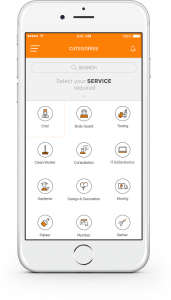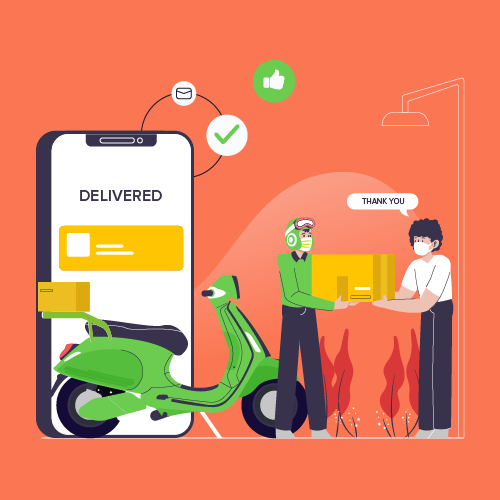How to Build a Successful On-Demand Delivery App?
Whenever we plan to go out, what’s the first thing we do- of course, we book an Uber ride! Today, the on-demand delivery applications like Uber, Airbnb, GrubHub, and Postmates have reshaped our world. The on-demand economy has surpassed the traditional business models; allowing people to get instant access to what they want and where they want.
“An On-demand delivery app is a mobile application that empowers you to request a product/service through the app and get it delivered on your doorstep.”
Being popular in the market for the last few years, the on-demand delivery apps have become the new face of the market. And it is expected that they will remain flourishing the coming years; becoming a staple part of our living. After all, who does not want mobility and convenience of getting anything and everything?
In such a scenario, if you are willing to build your own on-demand delivery mobile application, you must be well-versed with the growing competition and steps to build a user-centric on-demand delivery app. In this article, we are going to talk about everything related to how to start an on-demand delivery business.
Let us take you through everything you should know about the process to build on-demand delivery app, step-by-step.
Starting with the Types first.

Types of On-demand Delivery Applications
Business to Business
B2B on-demand apps are ideated to connect businesses from businesses. In this case, the service providers and service takers are not the end users of the product or service – they are simply the facilitators.
Business to Consumers
B2C applications are those which facilitate businesses to provide products or services to the end-users. This model is usually followed by businesses who have the delivery capability to take the products from their office to the consumers – Starbucks, Dominos, etc.
Consumers to Consumers
Popularized by brands like Etsy, BlaBla Car, and eBay, etc. these on-demand apps are those which connects the end-users to the end-users. In this case, the users themselves create products or offer services for other users to purchase or use.
On-demand delivery app development Use Cases
Whenever we talk about on-demand apps, especially on the delivery front, there is hardly any industry left which has not found an expansion in on-demand delivery service apps.
Here are some of the faces that the development of on-demand delivery apps takes.
Food & grocery delivery
On-demand food delivery app development is one of the most popular models of the real-time delivery space. Brands like UberEats, InstaCart, and GrubHub have been ruling the space for some time now, while a number of others have also entered the flourishing segment.
Healthcare
The next growing industry in the on-demand delivery segment is healthcare. There are multiple use cases that can be drawn in the on-demand healthcare space. You can help connect doctors and patients in real-time or you can create on-demand delivery app which facilitate making medicine or other hospital equipment reach the one in need.
Travel
It is impossible to talk about how to build a successful app and not mention the travel space. Especially since brands like Uber are what laid down the groundworks of successful on-demand application.
Home Services
While not as mainstream as the others in the list, on-demand home services apps are catching up pretty soon too. These apps are being used by people across the world to get help with things around their house – cleaning, beauty and wellness, movers and packers, etc.
The Anatomy of On-demand Delivery Apps
Something that every on demand app development company would tell you is that the creation of an on-demand delivery application entails creation of four versions:
The end-users – One of make use of the product or service
The parent company – One who operates the business and acts as the aggregators
The delivery persons – One who takes the product or offer services to the end-users
The admin – One who takes care of the applications’ working and functioning
The Key On-demand Delivery App Features
The on-demand delivery app features varies according to the stakeholders that we read in the previous section. Let’s look into them all individually.
Customer App Features
Login Page
This is the first screen that consumers interact with the moment they enter the application. Here, they either sign-up or sign-in into the application to explore it further.
Profiles
Every customer should be given the facility to create and then keep their profiles updated. This functionality of the on-demand delivery app is the space where they fill in their information – name, addresses, contact information, preferred payment mode, etc.
Search
This is one of the most important parts of the on-demand delivery application. Using this functionality, customers can search for what they are looking for, while looking at the detailed pages containing product/service details, prices, and reviews.
Order Placement
Once the users have selected the product/service they get to the part of placing or scheduling the order. They can either order in real-time or schedule the service for a later hour.
Payment
Here, users are given multiple payment options to choose from – they can either go with pay at home or make payment from their saved debit or credit cards.
Geolocation Tracking
Using this functionality, customers can track how far their order or service provider is so that they can prepare for them in advance.
In App Call/Messaging
While not necessary, an in-app call or messaging functionality is generally provided to the end users getting in touch with the service provider or the parent company from inside the application.
Push Notifications
Using this tool, the consumers are kept updated on their order status in real-time. It can also be counted as an important of app marketing tool.
Reviews and Ratings
This is the function that users use to rate and review the services they have received. You can give them the option to add comments in addition to the provision of passing star ratings.
Admin App Features
Content management
Using this feature, the admin can update the content of the product or service – update the price, contact details, and the work hours, amongst other things.
Order management
This section keeps the details of all the orders made, delivered and their feedback, along with the payment details, on the system.
Delivery Personnel App Features
Personal Account
This feature includes showcasing of the personnel’s personal information and the earnings that they have made along with the service details they have offered in a single view.
In-App messaging or calling
Using this feature, the personnel can get in touch with the end-users and ask them for directions or any other last minute query that they have
GPS Support
Using this functionality, the delivery people will be able to track the directions of the place where they have to deliver the order or service in real-time.
Now that we have looked at the basics of what you need to know to answer how to build a successful on-demand delivery application, let us end the discussion by giving you insights into the challenges that you might face when you enter the journey.
Main Challenges Associated With Developing On-Demand Delivery Applications
A. Identifying the right target audience
It is very easy and yet a grave mistake to start the on-demand delivery business under the assumption that everyone needs the service you are out to offer. But that is rarely the case. You will have a very clear understanding of the target audience to understand what all the services they are willing to outsource vs what they prefer performing themselves.
B. Finding Businesses and Service Providers to partner with
Finding associates is one of the most common challenges that businesses face, after all these associates tend to become the face of their business. What is necessary at this stage is to partner with people whom you can enjoy a mutually beneficial relationship with.
Only when you are able to attain a co-dependent nature of partnership, you will be able to make the partnership long-term.
How Much Does On-demand Delivery App Costs?
Regardless of whether you wish to know the cost of on-demand grocery delivery app, food delivery app or medicine delivery application, it is nearly impossible to share the exact valuer of any of these without having a complete understanding of the project you want to get made. So, get in touch with our business analysts today and share your business idea to get an estimate of how much an on-demand delivery app would cost you.
Now that you know the things that will bring you up to the stage of developing a successful on-demand delivery application, it is time to get started with the space.

strategies your digital product..



